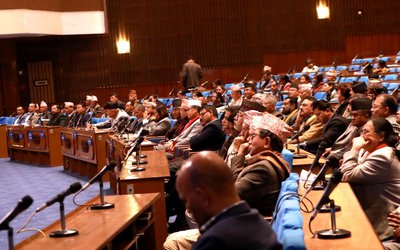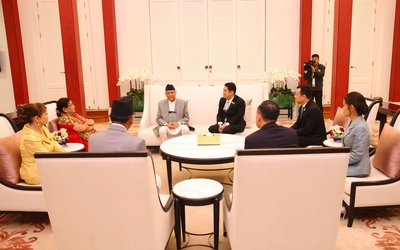More on News




Some people are making efforts to minimize the historical role played by Constituent Assembly (CA) in the last two years. The CA is facing attacks from its critic as well as its supporters. As a member of CA, I can claim that the CA has completed gigantic work in its two-year tenure. Regressive and reactionary forces always tried to discredit the CA to prove their logic that CA cannot make a constitution. It is very unfortunate that even progressives and supporters of Loktantra, who took part in the historic Janandloan II, are criticizing the CA. I agree that the CA is unable to work as per the aspirations of the people but it does not mean that the CA members spent their two years without doing anything. The bundles of reports of thematic committees are testimony to our efforts.
Experiences have shown that it is easier to bring change but what is difficult is to consolidate it. After the elections of the Constituent Assembly two years ago, the people had high expectations. One of the major expectations was to see the new constitution promulgated by the CA by May 28, 2010 giving the final shape to a democratic, federal republic. Of course, we were unable to promulgate the new constitution in time but it is injustice to blame CA for all the failure. I am proud to say that the CA has completed almost 80 percent of the works related to constitution in the last two years.
All the thematic committees have presented their drafts to CA and the Constitutional Committee is working on the report. In one word, what I can say is that we have ‘skeleton’ of the new constitution and what we need to do in the extended one year period is to put everything on the skeleton and make it come alive. Despite so many weaknesses and failures to bring the new constitution in two years’ stipulated time, Constituent Assembly has completed enormous work necessary to frame the new constitution.
After the extension of the tenure for another one year, the CA is now again preparing to draft the constitution. Our focus is on settling the dispute over issues like forms of the government and other minor issues. Personally, I too don’t feel comfortable about the extension of the tenure but we didn’t have any alternative other than to extend the tenure by amending the constitution. Actually, no Constituent Assembly in the world has promulgated the constitution in two years. A two-year period is too short to draft the constitution in a multi-ethnic, multi-lingual and diverse geographical country. In India, South Africa and Bolivia, they spent a long time to frame their constitutions. Compared to other countries, what we have done is a miracle as we completed 80 percent of our work. I am certain that the new constitution will be promulgate within a year. Whether one likes it or not, no political party had any alternative on May 28 other than to amend the constitution and extend the tenure for one year. Extension of tenure was not our wish but compulsion. Since there is a provision in the constitution for the amendment, the step to extend the tenure is constitutional.
The Constituent Assembly was given just a two year short tenure to complete so many things. There are so many tricky issues like turning the country from unitary state to federal. As a member of the State Restructuring and Power Sharing Committee, I can recall it took us almost 18 months to submit the draft. With a country of more than 100 ethnic groups, geographical diversity and resource constrains, it is a very complicated job to carve the sates and provinces for the federal Nepal. Of course, people criticized our model. I can claim that it was the best model in the existing state. I cannot claim that carving Nepal into 14 states is hundred percent correct but there is no alternative either. We carved the provinces taking in mind of the ethnic identity, resources, capability and geography. In choosing the name, we named some states on the basis of ethnicity, historical continuity and geography. We settled all the tricky issues in making the country federal. I can claim that nobody can stop us now from turning Nepal into a federal republic. We also proposed for political priority for certain community who are historically oppressed in the provinces. This is a compensation for the oppressed and suppressed classes. In one word, the report of the state restructuring committee will settle all the issues related to ethnicity and power sharing.
After the establishment of federal, democratic republic, Nepal has made a lot of progress. The changes brought about by the People’s Movement II was memorable as it turned Nepal into a Democratic, Federal Republic by ending 240-year long rule of discriminatory Shah dynasty. Along with this, Nepal also made so many achievements in the last four years. Along with abolishing monarchy, we were also able to declare Nepal as a secular state. These were the major achievements. There are many challenges before us. One of the challenges is to consolidate the Loktantrik process. Although the interim constitution has already accepted that Nepal is going to be a federal state, there is a lot that needs to be done.
The abolition of monarchy was a jubilation for Dalits, Madheshis, Adibasi Janajati and women as all of them were oppressed during the 240 years of monarchy. As we have already submitted the report for state restructuring to the related committee, it is not far away now to see Nepal turning into a federal state where each community living in provinces can exercise their sovereign right to choose their own destiny. I cannot claim that our report will completely satisfy all the people but it is by and large a good report prepared looking at the existing reality of the country. It will address all the problems.
Of course, the newly elected Constituent Assembly is also unable to address all the aspirations of oppressed community of dalit, adibashi janjati, Madheshi and women, the situation now is much better than what it used to be.
Dr. Manandhar is a CA member.
(As told to New Spotlight at a program organized by Nepal Constitution Foundation)



